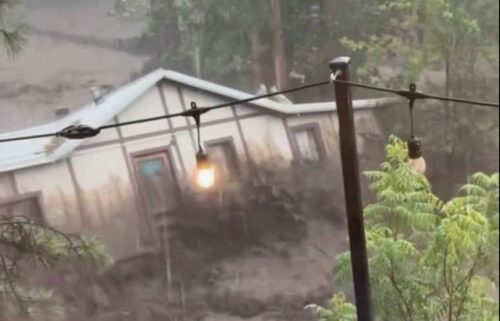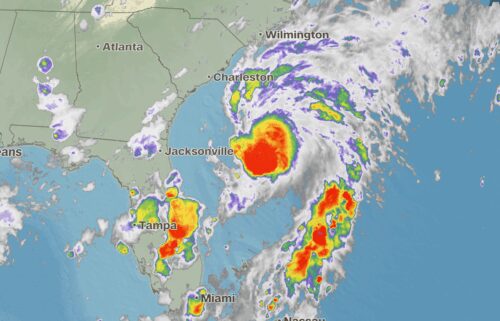Anger mounts in southeast Texas as crippling power outages and heat turn deadly
By Elizabeth Wolfe, Ashley Killough and Ed Lavandera, CNN
(CNN) — Frustrations are mounting across southeast Texas as residents enter a fourth day of crippling power outages and heat, a combination that has proven dangerous – and at times deadly – as some struggle to access food, gas and medical care.
Nearly 1.3 million homes and businesses across the region are still without power after Beryl slammed into the Gulf Coast as a Category 1 hurricane on Monday, leaving at least 11 people dead across Texas and Louisiana. The storm continues to threaten flooding Thursday in New England.
Gov. Greg Abbott has requested an investigation of CenterPoint Energy – Houston’s primary utility company that is responsible for restoring the vast majority of outages – and electric companies in the wake of the outages, Lt. Gov. Dan Patrick said during a news conference Thursday.
The investigation will look into what the problems were in the utilities’ response to Hurricane Beryl. “I’m sure we will find that there are things they could have done better,” Patrick said.
Many residents are sheltering with friends or family who have power, but some can’t afford to leave their homes, Houston City Councilman Julian Ramirez told CNN Wednesday. And while countless families have lost food in their warming fridges, many stores are still closed, leaving government offices, food banks and other public services scrambling to distribute food to underserved areas, he said.
As residents desperately try to cool their homes with generators, carbon monoxide poisoning has become a serious concern. At least two people have died in Harris County from carbon monoxide poisoning and fire departments have received more than 200 carbon monoxide poisoning calls in 24 hours, local officials said.
Beyond that, a 71-year-old woman died near Crystal Beach after her oxygen machine ran out of battery power and her generator shut down.
Heat-related medical emergencies are also spiking in Houston, as 90-degree temperatures blanket southeast Texas, Fire Chief Samuel Peña said. The heat index – a measurement of how the body feels under both heat and humidity – could reach 106 degrees in some areas, a life-threatening scenario for people without adequate cooling.
The dangerous heat – driven by human-caused climate change – hasn’t been limited to Texas. At least 28 heat-related deaths in the West have been reported since July 1, as a record-breaking heat wave beats down on states including California, Oregon and Arizona.
Essential operations, including hospitals and senior living homes, have been prioritizing powering medically necessary equipment. Some Houston hospitals are at risk of overcrowding as they cannot release patients to homes without power, prompting city officials to organize overflow beds in an indoor sports stadium, Patrick, the lieutenant governor, said Tuesday.
Nine fire stations in Houston have closed and relocated because they did not have generators, Peña said, even as emergency calls flood in.
Animal rescue teams and pet owners have also been working overtime to protect fuzzy companions. Pug Hearts Houston owner Cindy Rothermel said she heard of pug owners sitting in their cars with the A/C running to cool the dogs down in “intolerable” heat.
Texans losing patience with utility company
More than 1 million CenterPoint customers remain without power as of Thursday afternoon.
Beryl’s impact left more than 2.2 million customers without electricity on Monday. By Wednesday night, CenterPoint said it had restored power to 1.1 million customers and hoped to have an additional 400,000 restored by Friday and 350,000 more by Sunday.
But roughly 500,000 customers in the Houston area will not have electrical power restored until sometime next week, according to a CenterPoint Energy executive who spoke Thursday before the Texas Public Utility Commission.
The homes and businesses most affected by the power outage are in the areas hardest hit by Hurricane Beryl on the southern side of Houston and up through the Interstate 45 corridor, said Jason Ryan, CenterPoint’s executive vice president for regulatory services and government affairs.
The private utility says these neighborhoods suffered massive electrical infrastructure damage, with fallen trees and branches dismantling powerlines that now need to be replaced by crews on the ground.
“We know we still have a lot of work to do,” said Ryan. “I know customers are frustrated.”
As the miserable conditions persist, anger is spreading among those who say the utility should have been more prepared for the storm.
“Almost universally people have lost patience with CenterPoint,” Ramirez, the councilman, told CNN. “CenterPoint can’t seem to tell us how long this is going to last.”
Just north of Houston in Spring, Texas, Elizabeth Garrison, 65, and her husband, 77, are enduring nearly 90 degree temperatures in the house without air conditioning, she told CNN.
Now on their fourth day without power, the pair are making do with just two fans, one battery-powered and the other hooked up to a neighbor’s generator.
“You get very very warm, you open the windows and you just try to drink a lot of liquids,” Garrison said. “It was okay because we heard on Wednesday that a lot of people were going to get their power. So it’s like OK, I can make it Tuesday. But then Wednesday evening comes and you don’t have power and it’s even worse.”
In Fort Bend County, southwest of the Houston area, Sheriff Eric Fagan said authorities received a call “that a CenterPoint Energy worker had a gun pulled on them.”
“We all need to be calm and patient,” the sheriff said in a news conference Thursday. “Everyone is working hard out there 24/7… You have to realize CenterPoint called people outside of the state to help with this emergency.”
The sheriff warned, “We will not tolerate them being abused, let alone having a gun pulled on them.”
Several members of the Texas Public Utility Commission have urged company officials to improve communication as part of “rebuilding trust” with customers in the hurricane-damaged areas.
“Infrastructure is going to break,” said Thomas Gleeson, chairman of the state commission. “Things are going to happen. But if people feel like they’re being effectively communicated with, it makes it a lot easier to go through.”
Just after July 4, about three days before the storm hit the Texas coast, Ryan, the CenterPoint executive, said the utility put out its first request for 3,000 “mutual assistance” workers to pre-position ahead of the storm. As the path of the storm moved east and closer to the Houston area in the final days before landfall, CenterPoint says it increased the request for repair crews to 10,000.
The utility said Thursday morning it would begin providing estimated restoration times on its status tracker. CenterPoint Vice President of Operations Darin Carroll told CNN affiliate KHOU the pace of repairs will begin to slow as the community moves deeper into disaster recovery.
Additionally, Carroll told the station the utility aimed to improve the accuracy of its power outage map, which has been criticized by residents across social media for having inaccuracies, including saying power is restored where it is not.
The city council grilled a CenterPoint executive on Wednesday, asking why the company hasn’t done more to prepare for storms.
Brad Tutunjian, CenterPoint vice president of electric distribution and power delivery, said they’ve never seen an incident to this magnitude and described it as the “largest outage in our history.”
Three months before Hurricane Beryl hit Texas, CenterPoint Energy estimated it would need $2 billion to harden its system against worsening extreme weather.
The company reported it needed to restore power after 15 extreme weather events between 2019 to 2023. The longest restoration time to date was after the deadly winter storm and brutal cold snap in February 2021, when it took 116 hours and 40 minutes to restore power to more than 8 million impacted customers.
Much of Texas’s electrical infrastructure was built in the 1970s and 1980s, when weather was less extreme, Joshua Rhodes, an energy research scientist at UT Austin, told CNN. The string of storms Texas has been hit with in recent years is now taking a toll.
“It’s not a surprise the infrastructure built for milder weather is failing more often,” Rhodes said.
Elder care facilities struggle without power
Senior care facilities and residents who rely on electric medical devices are particularly at risk as power outages stretch through at least the end of the week.
CrowdSource Rescue, a nonprofit primarily serving as a search-and-rescue group, identified roughly 120 living facilities for seniors that need help. The group has helped deliver generators and supplies to 16 so far.
“The whole city is hurting and suffering. That’s what it feels like right now, from my vantage point,” said Matthew Marchetti, a co-founder of CrowdSource Rescue. “But I think for the seniors, they’re taking the brunt of it. So we’re trying to do everything we can.”
Marchetti said his teams typically set up an AC unit and generator in one part of a facility – like a community room or a leasing office – for people to gather and cool off, but the challenge has been moving people down to those rooms from high floors in buildings with no working elevators.
After two days of flood-related issues, mold, no power and excruciating heat, 57-year-old Frankie Thibideaux said she left her Houston-area residential building to stay in a hotel. But she remains worried about the mostly elderly residents who occupy the building in Missouri City, just southwest of Houston, Thibideaux told CNN.
Many of them live on the third and fourth floor, she said, but several have no way of getting down because they rely on walkers or wheelchairs.
“People up there are on dialysis,” Thibideaux said. “It’s sad. They’re trying to keep their medicine cold, but there’s no ice anywhere.”
Storm brought tornadoes, flooding to Northeast
The National Weather Service in Buffalo, New York, confirmed two tornadoes in the area Wednesday, as the remnants of Beryl tracked across the state.
The local weather service issued nine tornado warnings Wednesday –- the most ever put out in a single day.
Flash flood warnings were in effect Thursday morning from northern New York to central Maine, with early morning flash flooding in Vermont and New Hampshire.
As the system continues to move east-northeast, the bulk of the storm’s impacts are expected to be over for most of New England.
Over 100 people have been rescued and a body was recovered from floodwaters after Beryl’s remnants swept through Vermont Wednesday, according to state officials. The fatality has not officially been tied to the storm, but officials believe a man was in a vehicle that was swept away in water, according to Public Safety Commissioner Jennifer Morrison.
The-CNN-Wire
™ & © 2024 Cable News Network, Inc., a Warner Bros. Discovery Company. All rights reserved.
CNN’s Lauren Mascarenhas, Brad Parks, Ella Nilson, Amanda Jackson, Robert Shackelford, Joe Sutton and Sarah Dewberry contributed to this report.


